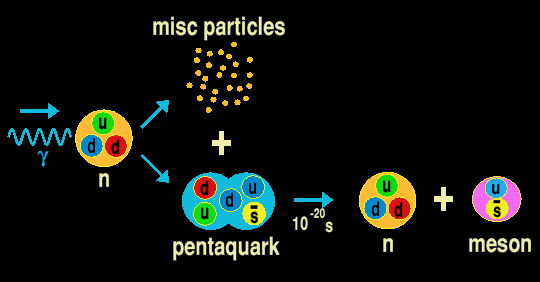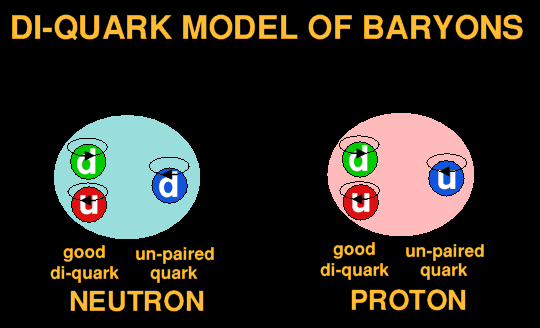

Then in June 2003 such a pentaquark was created by bombarding a neutron with a high-energy gamma ray. This reaction occasionally, perhaps one in 5 million other interactions, created a penta-quark but otherwise a plethora of other miscellaneous particles. The pentaquark lasted just 10-20 seconds before decaying back into a neutron plus a strange meson (one containing a strange quark, or to be more precise, an anti-strange quark). Its mass is 1540MeV, and is called the theta pemta-quark. Other pentaquarks should also be possible, but this is the one that was observed. Other combinations of quarks are possible, but some have higher mass and would decay too fast to be detectable.
It turns out that quarks possess not only spin, which comes in two orientations, but also colour, which also comes in two orientations. At extremely high densities, such as occur in neutron stars, quarks seem to pair up. If they pair up with both spin and colour in different orientations, then their motions become locked together (as happens with electrons in superconductivity, where electrons pair up with anti-parallel spins in what are known as Cooper pairs) and their overall mass is reduced, they are more stable - they are 'good di-quarks'. If the quarks are not paired up with both spin and colour of opposite orientation, then their random motions increase, and thus their mass; they are more unstable - a 'bad di-quark'. When you put two di-quarks together, their overall colour is just a single colour, so you need to add just one more quark of opposite colour to produce a colourless penta-quark. In the above diagram of an anti-quark, the red and blue down and up quarks could be one di-quark, whilst the green and yellow up and not-strange quarks the other di-quark. The four quarks together would have colour yellow (anti-blue). So a blue quark (the down quark in the middle) would be required to make the penta-quark white. Seventeen other penta-quark states made of pairs of good di-quarks and a quark are predicted, with mass about 1760MeV.
However, two years later, this research is now cast into serious doubt. Another experiment over 50 times more sensitive than the above and set up especially to look for penta-quarks has failed to find any at all. They fired energetic gamma ray photons at liquid hydrogen, which should change the protons into an abundance of pentaquarks if they exist. Any resultant pentaquark would have decayed into a K+ meson plus a neutron, but no such signature was observed. Further experiments are underway to explore higher energy regimes. The pentaquark cannot be written off yet.

It should be noted that the pentaquark is only possible because it is colourless, being composed of three quarks couloured red green and blue (colourless) plus two other quarks with colour and anti-colour (which in the diagram shown are blue and yellow, but in reality, because of the interaction of between the quarks and the bi-coloured gluons, the individulal colours of all the quarks within the pentaquark are continually changing, this being the basis of the strong colour force binding quarks and gluons together).
The pentaquark may have been common in the Universe just after the Big Bang, 13.81×109 years ago, when the Universe was extremely hot and atomic nuclei had yet to condense from the quark-gluon plasma, which probably had a veritable zoo of other exotic particles amongst them.
By studying pentaquarks scientist hope to shed more light on the not-well-understood forces between neutrons and the gluons which keep the quarks together.
![]()
![]()